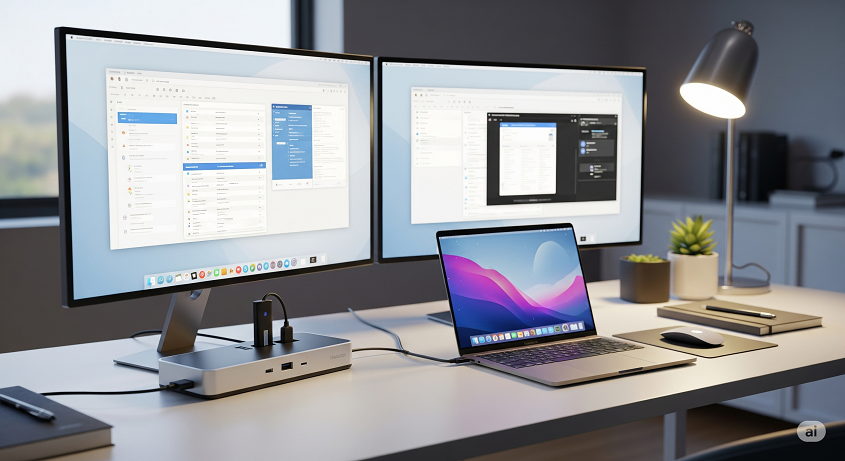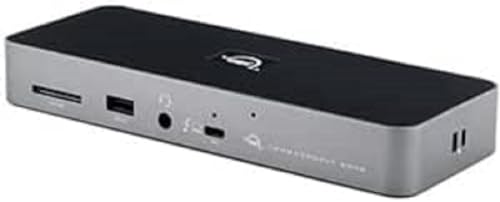
The Ultimate USB-C Docking Station Dual Monitor Setup Guide for 2025
Affiliate Disclosure: As an Amazon Associate, we may earn from qualifying purchases. This helps support HushDesk at no extra cost to you.
Readers’ Guide
It’s Monday morning, you’re settling into your home office with your laptop, and instead of the usual cable chaos, you simply plug in one USB-C cable. Instantly, your dual monitors spring to life, your keyboard and mouse connect, and your laptop begins charging. This isn’t a productivity fantasy—it’s the reality of modern USB-C docking station dual monitor setups that are revolutionizing workspaces in 2025.
The remote work revolution has fundamentally changed how we approach our workstations. According to recent workplace efficiency studies, professionals using dual monitor setups with streamlined connectivity report 23% higher productivity compared to single-screen users. This surge in productivity isn’t just about screen real estate—it’s about creating seamless, clutter-free environments that let you focus on what matters most.
Whether you’re searching for a USB-C docking station dual monitor with power delivery solution or troubleshooting why your USB-C docking station dual monitor not working properly, this comprehensive guide will walk you through everything you need to know to make an informed decision in 2025.
Why USB-C Docking Stations Are Essential for Modern Productivity
The shift toward USB-C connectivity represents more than just a new port standard—it’s a fundamental reimagining of how we connect our devices. Dr. Sarah Chen, a workplace ergonomics specialist at Stanford University, explains: “USB-C docking stations eliminate the physical and mental overhead of managing multiple cables, allowing professionals to transition between mobile and desktop work modes effortlessly.”
Modern USB-C docking station dual monitor solutions offer several key advantages:
Simplified Connectivity: One cable handles video output, data transfer, and power delivery simultaneously. This means you can connect your laptop to dual monitors, charge your device, and access peripherals through a single connection point.
Enhanced Productivity: Research from the University of Utah’s Department of Information Systems found that workers using dual monitor setups completed tasks 44% faster than those using single monitors. When combined with the seamless connectivity of USB-C docking stations, this productivity boost becomes even more pronounced.
Future-Proof Investment: As more devices adopt USB-C as the standard, investing in a quality docking station ensures compatibility with current and future hardware.
Cleaner Workspace Aesthetics: A well-designed docking station transforms cable management from a constant struggle into a one-time setup. This cleaner environment contributes to reduced stress and improved focus throughout the workday.
Top USB-C Docking Station Dual Monitor Solutions for 2025
1. CalDigit TS4 Thunderbolt 4 Dock
- 18 Ports of Extreme Connectivity – Featuring an impressive 18 ports, the TS4 has enough connectivity for even the most d…
- Powerful 98W Charging – The TS4’s power delivery is ideal for any Thunderbolt or USB-C host device, including larger scr…
- Single 8K or Dual 6K 60Hz Displays – Windows users can connect a single monitor up to 8K resolution. macOS users can con…
Pros:
- Supports dual 4K monitors at 60Hz via Thunderbolt 4
- 98W power delivery for fast laptop charging
- 18 total ports including multiple USB-A, USB-C, and SD card slots
- Excellent build quality with aluminum construction
Cons:
- Premium price point may not suit all budgets
- Requires Thunderbolt 4 compatibility for full functionality
Best For: Professional content creators and power users who need maximum connectivity and don’t mind investing in premium hardware.
2. Anker PowerExpand Elite 13-in-1
- Compatibility Information: Works with Windows laptops or non-M1 MacBooks equipped with a Thunderbolt 3 or 4 port. Not co…
- Incredible Expansion: Equipped with dual Thunderbolt 3 ports, 2 USB-C ports, 4 USB-A ports, an HDMI port, an Ethernet po…
- Unparalleled Charging Options: With 85W and 15W Thunderbolt 3 ports plus an 18W USB-C Power Delivery port, PowerExpand o…
Pros:
- Dual HDMI outputs supporting 4K at 30Hz
- 85W power delivery sufficient for most laptops
- Comprehensive port selection including Ethernet
- Reliable performance with wide device compatibility
Cons:
- HDMI limited to 30Hz refresh rate at 4K resolution
- Some users report occasional connectivity hiccups with certain laptop models
Best For: Business professionals and home office users seeking a balance between features and affordability.
3. Dell WD19S USB-C Docking Station
- Dell ExpressCharge allows you to charge up to 80% in one houri, making it the most efficient way to manage the workday.
- Get more done, even faster with Dell ExpressCharge Boost – a feature that provides up to a 35% charge in just 20 minutes…
- Increase your power delivery and charge even faster with a dock that delivers up to 90W of power with 130W power adapter…
Pros:
- Native DisplayPort and HDMI outputs for flexible monitor connections
- 90W power delivery compatible with most business laptops
- Solid build quality with Dell’s enterprise-grade reliability
- Comprehensive driver support across Windows and macOS
Cons:
- Bulky design takes up more desk space than compact alternatives
- Some MacBook users report compatibility issues with specific models
Best For: Enterprise users and Dell laptop owners who prioritize reliability and official manufacturer support.
4. Plugable Universal Laptop Docking Station
- Flexible Expandability: Featuring a hybrid 2-in-1 USB 3.0 and USB-C cable, a single connection from a host PC to this US…
- Dual HD Monitors: Supports dual HDMI displays up to 1920×1200 @ 60Hz refresh rate. Capable of 2560×1440 @ 50Hz with a si…
- Compatibility: Universal compatibility with Windows 11, 10, 8.x and 7, macOS 10.14 or later, and ChromeOS 100 or later. …
Pros:
- Dual 4K support via DisplayPort and HDMI
- 60W power delivery adequate for ultrabooks
- Compact design perfect for space-conscious setups
- Excellent customer support and documentation
Cons:
- Lower power delivery may not charge gaming laptops adequately
- Limited to 4K at 30Hz on HDMI output
Best For: Budget-conscious users with ultrabooks or lightweight laptops who need reliable dual monitor support.
5. WAVLINK USB-C Universal Docking Station
- Flexible Extensibility: A single USB C connection from a host PC to this dock provides dual HDMI and DisplayPort outputs…
- Dual 4K/ Single 5K Display: Featuring DisplayPort and HDMI ports, it supports dual 4K monitors resolution up to 4096×216…
- 100W Power Delivery Port & USB Ports: If your laptop supports USB-C Power Delivery, this Docking Station with 130W power…
Pros:
- Affordable entry point into dual monitor docking
- Multiple video output options including VGA for legacy monitors
- Decent build quality for the price point
- Wide compatibility across different operating systems
Cons:
- 60W power delivery insufficient for high-performance laptops
- Video performance can be inconsistent with demanding applications
Best For: Students and casual users who need basic dual monitor functionality without premium features.
Specialized Solutions for Specific Needs
- All the Thunderbolt you’ve always wanted: For the first time ever, add more full speed and fully functional Thunderbolt …
- Reinvents the Daisy Chain: Create multiple independent “tree branches,” connect multiple bus-powered devices
- More power: Up to 96W of laptop charging power
Pros:
- Optimized for Mac compatibility with seamless macOS integration
- High-quality Thunderbolt 3/4 performance
- Compact design with premium materials
- Excellent technical support from OWC
Cons:
- Limited Windows compatibility compared to universal solutions
- Fewer total ports than similarly priced alternatives
Best For: Mac users who prioritize seamless integration and premium build quality over maximum connectivity options.
7. Kensington SD5700T Thunderbolt 4 Docking Station
- Compatible OS: Docking station that can be started using Plug&Play. Backwards compatible with Windows laptops with Thund…
- Thunderbolt 4 Technology: Thunderbolt 4 technology allows you to connect 3 additional Thunderbolt devices (up to 5) Tran…
- Single 8K or Dual 4K Video Output to Thunderbolt 4 Supported Devices: Ultra HD (single 8K 30Hz or dual 4K 60Hz) with cle…
Pros:
- Dual 4K at 60Hz support via Thunderbolt 4
- 90W power delivery suitable for most professional laptops
- Kensington’s enterprise-focused security features
- Robust build quality designed for heavy daily use
Cons:
- Premium pricing may exceed budget constraints
- Thunderbolt 4 requirement limits compatibility with older devices
Best For: Enterprise users and security-conscious professionals who need reliable, high-performance docking with advanced features.
Critical Limitations to Consider
While researching USB-C docking station dual monitor solutions, it’s important to understand that not all products deliver on their promises. Two products that consistently receive criticism from users deserve special attention:
Generic Amazon Basics USB-C Hub: Despite its attractive price point, this product suffers from significant reliability issues. Users frequently report that the USB-C docking station dual monitor not working after just a few months of use. The power delivery is inconsistent, often failing to maintain stable connections to external monitors during intensive tasks.
AUKEY USB-C Hub with Dual HDMI: While initially appealing for its compact design, this unit has fundamental thermal management problems. Extended use often results in overheating, causing video output to stutter or disconnect entirely. The advertised 4K support is misleading, as most users experience significant lag when running dual 4K displays simultaneously.
These limitations highlight why investing in quality docking stations from reputable manufacturers is crucial for long-term reliability and productivity.
Complete Buying Guide: Making the Right Choice
Selecting the perfect USB-C docking station dual monitor setup requires careful consideration of several factors. Here’s a comprehensive comparison to help guide your decision:
| Feature | Budget ($100-150) | Mid-Range ($150-250) | Premium ($250+) |
| Power Delivery | 60W | 85-90W | 90-100W |
| Video Resolution | 4K@30Hz | 4K@60Hz (limited) | 4K@60Hz (dual) |
| Build Quality | Plastic, adequate | Mixed materials, good | Aluminum, excellent |
| Warranty | 1 year | 2 years | 2-3 years |
| Port Selection | 8-10 ports | 10-13 ports | 15+ ports |
Power Delivery Considerations
When evaluating USB-C docking station dual monitor with power delivery options, matching the power requirements to your laptop is crucial. Most ultrabooks function well with 60W delivery, but gaming laptops and high-performance workstations typically require 90W or more for optimal charging while under load.
Marcus Rodriguez, a certified IT infrastructure specialist, notes: “Power delivery isn’t just about charging speed—it’s about maintaining system stability. Insufficient power delivery can cause performance throttling, especially when driving dual 4K monitors simultaneously.”
Video Output Compatibility
The type of video outputs your docking station provides directly impacts your monitor setup flexibility. USB-C docking station dual monitor HDMI configurations offer broad compatibility with modern displays, while USB-C docking station dual monitor DisplayPort setups often provide better bandwidth for high-resolution, high-refresh-rate displays.
For USB-C docking station dual monitor MacBook Pro users, understanding Apple’s specific requirements is essential. Newer MacBook Pro models work excellently with Thunderbolt 4 docks, but older USB-C models may require specific compatibility verification.
Connectivity and Future-Proofing
Jennifer Liu, a workplace technology consultant, emphasizes: “The best docking station investment is one that grows with your needs. Look for solutions that offer multiple connection types and sufficient bandwidth to handle future display upgrades.”
Consider whether you need USB-C docking station dual monitor 2 HDMI outputs specifically, or if a mixed HDMI/DisplayPort configuration would better serve your current and future monitor setup.
Troubleshooting Common Issues
Many users search for solutions when their USB-C docking station dual monitor not working as expected. Here are the most common issues and their solutions:
Problem: Monitors not detected after connecting docking station Solution: Ensure your laptop’s USB-C port supports video output (not all USB-C ports do). Update your laptop’s graphics drivers and check that the docking station firmware is current.
Problem: Inconsistent power delivery or charging issues Solution: Verify that your laptop’s power requirements don’t exceed the docking station’s output capacity. Some laptops require specific Power Delivery profiles for optimal charging.
Problem: Video output stuttering or display lag Solution: Check your display resolution and refresh rate settings. Running dual 4K displays at 60Hz requires significant bandwidth that not all docking stations can provide consistently.
Integration with Modern Workspace Solutions
As remote work continues to evolve, many professionals are discovering the benefits of combining their USB-C docking station dual monitor setup with ergonomic workspace solutions. Platform like hushdesk.store are pioneering innovative approaches to workspace design that complement modern docking station setups.
Their acoustic privacy solutions work particularly well in open-concept home offices where dual monitor productivity needs to coexist with household activities. The integration of sound dampening with streamlined connectivity creates workspaces that are both highly functional and conducive to deep focus work.
Check out some of our home office setup guides:
Best Bias Lighting for Dual Monitor Setup: Transform Your Workspace in 2025
Best Home Office Set Up Ideas for 2025
Frequently Asked Questions
Q: Can I use a USB-C docking station dual monitor adapter with any laptop?
A: Not all laptops support video output through their USB-C ports. Check your laptop’s specifications to ensure the USB-C port supports DisplayPort Alt Mode or Thunderbolt for video output capability.
Q: Why is my USB-C docking station dual monitor setup not working with my MacBook?
A: MacBooks can be particular about docking station compatibility. Ensure you’re using a dock that explicitly supports macOS, and check that your MacBook model is listed in the compatibility specifications. Some older MacBook models have limited support for certain docking station features.
Q: How do I find USB-C docking station dual monitor nearby for testing?
A: Many electronics retailers like Best Buy, Micro Center, and Staples carry popular docking station models in-store. Call ahead to confirm availability, as inventory can vary. Some locations offer return policies that allow you to test compatibility with your specific laptop model.
Q: What’s the difference between USB-C and Thunderbolt docking stations?
A: Thunderbolt docking stations typically offer higher bandwidth, supporting dual 4K displays at 60Hz and providing more power delivery options. USB-C docks are more universally compatible but may have limitations in video resolution and power delivery capabilities.
Q: Can I daisy-chain multiple docking stations for more monitors?
A: While technically possible in some configurations, daisy-chaining docking stations often creates stability issues and bandwidth limitations. For more than two monitors, consider a single high-end docking station designed for multi-monitor support rather than multiple cheaper units.
Making Your Final Decision
Choosing the right USB-C docking station dual monitor solution ultimately depends on balancing your specific needs with your budget constraints. Consider your primary use cases: Are you a creative professional requiring color-accurate 4K displays? A business user focused on productivity and reliability? Or a student looking for affordable functionality?
The investment in a quality docking station pays dividends in daily productivity and workspace satisfaction. As remote work and flexible office arrangements continue to evolve, having a reliable, high-performance docking solution becomes increasingly valuable.
Remember that the best docking station is one that seamlessly integrates into your workflow, providing the connectivity you need without introducing complexity or reliability concerns. Take time to research compatibility with your specific devices, read user reviews, and consider long-term needs as you make your decision.
Whether you’re upgrading from a basic USB hub or building your first dual monitor setup, the right USB-C docking station dual monitor configuration will transform your workspace into a productivity powerhouse that adapts to your evolving professional needs.










